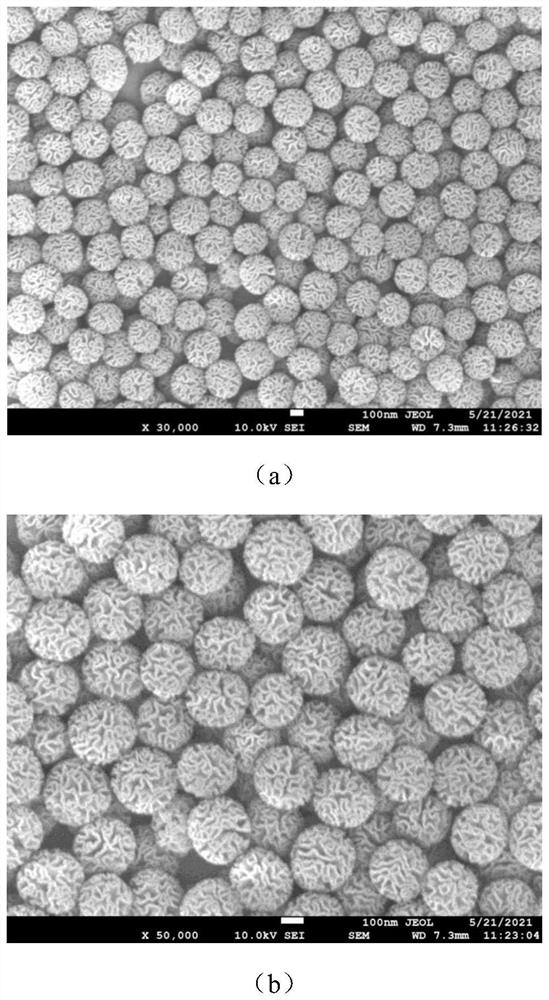Intelligent silicon dioxide nano pesticide for preventing and treating pine tree wilt
A nano-pesticide and application technology, applied in the field of intelligent silica nano-pesticide, can solve the problems of inability to kill pests in tree trunks, pests are prone to drug resistance, and poor controllability, so as to save complicated procedures and achieve pesticide reduction. , the effect of low cost
- Summary
- Abstract
- Description
- Claims
- Application Information
AI Technical Summary
Problems solved by technology
Method used
Image
Examples
Embodiment 1
[0054] (1) Add 60.7 μL of triethanolamine to 25 mL of purified water, and stir in an oil bath at 80°C for 30 minutes;
[0055] (2) Dissolve 380 mg of cetyltrimethylammonium bromide and 168 mg of sodium salicylate in the water-triethanolamine solution prepared in step (1), and continue stirring at 80° C. for 1 h;
[0056] (3) Add 4 mL (original) tetraethyl silicate to the solution prepared in step (2), and continue stirring at 80° C. for 2 h; after the reaction, centrifuge to obtain a precipitate, and wash with ethanol several times to remove unreacted substances;
[0057] (4) Add 1.54mL 36wt% concentrated hydrochloric acid and 120mL methanol to the precipitate obtained in step (3) and react three times at 60°C, each time for 6h, and centrifuge to remove cetyltrimethylammonium bromide to obtain DMSNs, The yield of the obtained DMSNs was 95.0%.
[0058] Yield of DMSNs=(actual yield of DMSNs / theoretical calculated yield of DMSNs)×100%.
[0059] (5) Take aloperine and dissolve i...
Embodiment 2
[0065] (1) Take 1g HAuCl 4 Dissolve in ultrapure water, set volume to 100mL, get 1wt% HAuCl 4 Solution, take 2.5mL and dilute 10 times to obtain 0.01wt% HAuCl 4 Solution, 250mL 0.01wt% HAuCl 4 The solution was placed in a 500mL three-necked flask, condensed and refluxed in an oil bath, heated to boiling, poured into 7.5mL of 1wt% trisodium citrate solution, and continued to stir for 20min to obtain the AuNPs solution.
[0066] (2) Take it out and put it in ice water to cool to room temperature and collect. Take 2 mg of DTTC, disperse it in 1 L of ultrapure water, stir for 30 min, and obtain a 3.67 mmol / L DTTC solution for later use. Put the AuNPs on a magnetic stirrer, take 2mg of DTTC and add 20mL of ultrapure water, and add the DTTC solution to the AuNPs solution drop by drop until the solution just changes color. Take 400mL of the discolored solution, add 50mL of MPEG-COOH and 50mL of MPEG dropwise, stir for 2 hours and then centrifuge, absorb the supernatant with a pip...
Embodiment 3
[0075] (1) Add 60.7 μL of triethanolamine to 25 mL of purified water, and stir in a water bath at 80° C. for 30 min;
[0076] (2) 380mg cetyltrimethylammonium bromide and 168mg sodium salicylate are dissolved in the water-cetyltrimethylammonium bromide-sodium salicylate-triethanolamine prepared in step (1) In the solution, continue stirring in a water bath at 80°C for 1h;
[0077] (3) Add 4 mL (original) tetraethyl silicate to the solution prepared in step (2), and continue stirring in a water bath at 80° C. for 2 h; after the reaction, centrifuge to obtain a precipitate, and wash with ethanol to remove unreacted substances;
[0078] (4) Add 240 μL of concentrated hydrochloric acid and 120 mL of methanol to the precipitate obtained in step (3) and react at 60° C. for 6 h three times to remove the template to obtain DMSNs. The yield of the obtained DMSNs is 94.0%.
[0079] (5) Take aloperine and dissolve it in ethanol to obtain an aloperine solution with a concentration of 1 m...
PUM
 Login to View More
Login to View More Abstract
Description
Claims
Application Information
 Login to View More
Login to View More - R&D
- Intellectual Property
- Life Sciences
- Materials
- Tech Scout
- Unparalleled Data Quality
- Higher Quality Content
- 60% Fewer Hallucinations
Browse by: Latest US Patents, China's latest patents, Technical Efficacy Thesaurus, Application Domain, Technology Topic, Popular Technical Reports.
© 2025 PatSnap. All rights reserved.Legal|Privacy policy|Modern Slavery Act Transparency Statement|Sitemap|About US| Contact US: help@patsnap.com



